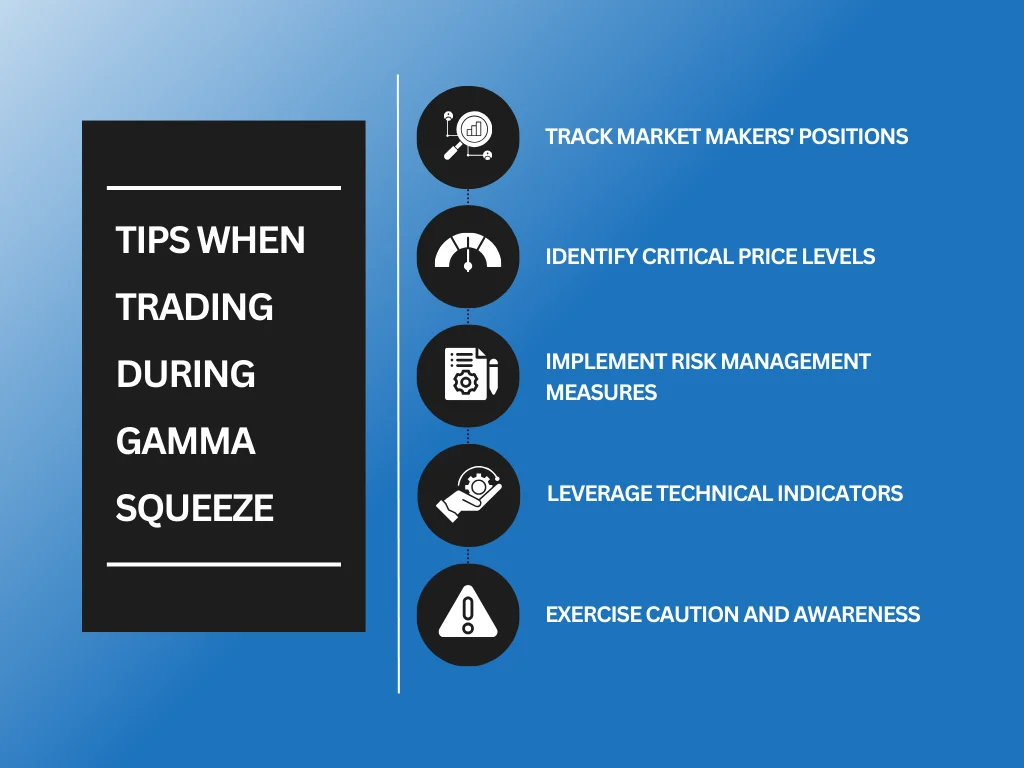
What is a Gamma Squeeze? Identifiers and Next Steps
For educational and information purposes only; not investment advice. Any Spartan Trading Service offered is for educational and informational purposes only and should not be construed as a securities-related offer or solicitation, or be relied upon as personalized investment advice.
A gamma squeeze significantly influences stock prices and market dynamics. This event occurs when the price of an option drives the underlying stock price up as market makers adjust their positions in the options market. Delving deeper into its intricacies considerably helps enhance your trading strategies and risk management efforts.
At Spartan Trading, we specialize in providing top-notch stock and option idea generation. We focus on how various options and trading strategies affect stock shares and the overall stock market. Our insights help retail investors and options traders navigate complex price movements and leverage options contracts for better outcomes.
Anchored by our experience and expertise, we’ve compiled this guide that explores the mechanics of a gamma squeeze. We’ll cover its crucial aspects, from short squeeze comparisons to analyzing its impacts on stock price and market behaviors. By the end, you’ll gain insights into how they can lead to higher stock prices, especially in cases of large trading volumes and big hedge funds.
Let’s dive in!
What is a Gamma Squeeze?
A gamma squeeze is a market event in the stock market where the price of an option drives the underlying stock price up. This occurs as market makers adjust their positions in the options market, creating a feedback loop that pushes the stock price higher.
Here are the reasons why a gamma squeeze happens:
- Large Amount of Call Options: When investors buy many call options, it can force market makers to purchase shares of the underlying asset to hedge their positions. This buying activity can push the share price up.
- Short Interest: High short interest in a stock, like AMC Entertainment or shares of GameStop, can exacerbate the price increase as short sellers cover their positions to minimize losses, further lifting the share price.
- Positive Delta Changes: As the delta of options increases due to price changes of the underlying security, it causes the options’ exposure to escalate price movements and leads to sensitivity of the option’s price.
- Retail Traders: An influx of retail traders into specific stocks, motivated by trading account tips or investment advice seen on Wall Street forums, can spike demand and push prices to higher levels.
- Short Stocks and Option Price Reaction: Traders shorting stocks may react to an initial price increase by closing positions, which, combined with the escalating option price due to delta changes, accelerates the asset’s price further.
Understanding a gamma squeeze is crucial for traders and investors engaging with digital assets or stocks like AMC. Awareness of how call options, short interest, and trading behaviors influence market dynamics can guide better investment decisions without violating legal requirements.
Gamma Squeeze vs Short Squeeze: What are the Differences
A gamma squeeze and a short squeeze both impact stock prices dramatically, but they trigger these shifts through different mechanisms. Understanding these distinctions can guide investors in navigating complex market scenarios. Here are the key differences between the two:
| Aspect | Gamma Squeeze | Short Squeeze |
| Driving Force | Accumulation of call options drives the prices | Short sellers covering positions drive it |
| Market Influence | Often involves fewer stocks | Affects a broader range of securities |
| Speed of Price Change | Rapid, often due to a specific expiry date | More gradual, depending on market sentiment |
| Volume Impact | High trading volumes aren’t necessary | Typically involves high trading volumes |
| Predictability | Harder to predict due to complex option layers | Easier to spot with high short interest |
While gamma and short squeezes can propel stock prices upward, they stem from distinct scenarios in options trading and short selling. Understanding these differences helps traders and investors strategize accordingly, potentially capitalizing on rapid shifts in market dynamics.
How to Identify a Gamma Squeeze: Key Indicators
Understanding a gamma squeeze requires knowing how options traders can significantly drive a stock’s price. This phenomenon usually involves a rapid stock price increase, influenced heavily by options, particularly call options. Here are some key signs to look out for:
The Role of Call Options
Call options give buyers the right, not the obligation, to purchase a stock at a predetermined price within a certain period. When traders anticipate that a stock will rise, they might buy a lot of call options. Market makers, who facilitate trading by selling these options, often buy the underlying stock to hedge their risk. This activity can push the stock’s price up.
Market Makers Hedging
Market makers purchase the underlying stock to offset the risk of selling call options. As the stock price increases, they must buy more shares to remain neutral. This buying pressure can further increase the stock price, creating a cycle that rapidly inflates stock values.
Increase in Stock Price
Market makers’ initial buying of shares leads to an uptick in the stock price. This increase can trigger more traders to buy call options, expecting the price to increase. Experiencing this demand causes even more buying from market makers, creating a feedback loop that continually pushes the price upward.
Trader Sentiment and Momentum
The role of trader sentiment and momentum must be considered. News of a rising stock attracts more attention, and the fear of missing out (FOMO) can drive more investors to jump in. This influx of buyers can accelerate the price increase, compounding the effect of it.
Expiration Clustering Effect
Option expirations can significantly intensify a gamma squeeze. As the expiration date approaches, traders who hold in-the-money call options may exercise them, leading to actual stock purchases. This clustering of expirations can lead to large volumes of stock being bought over a short period, sharply escalating the stock’s price and the squeeze’s intensity.
Tips When Trading During Gamma Squeeze
Trading during a gamma squeeze requires careful navigation due to its high-risk, high-reward nature. This strategy involves capitalizing on rapid price movements driven by surges in options activity. Here are some tips to effectively trade and potentially profit from volatile market:
Tip 1: Track Market Makers’ Positions
Understanding the positions of market makers is crucial when preparing to trade a gamma squeeze. Market makers often hold large portfolios of stocks and options, influencing liquidity and price stability.
These professionals adjust their positions based on current market conditions. Traders should monitor these adjustments closely as they can indicate the beginnings of a gamma squeeze. Tools like options order flow data and real-time trading volumes provide insights into these movements.
Here are the factors to consider when tracking the maker’s position:
- Imbalance in Trading Volume: Look for unusual increases in trading volumes, especially in call options, which can signal market makers adjusting their positions to cover their risks.
- Changes in Option Open Interest: Significant changes in open interest highlight new positions being established or old ones being closed, often a precursor to market shifts.
- Price Volatility of Underlying Stocks: High volatility can force market makers to rebalance their portfolios more frequently, potentially leading to a gamma squeeze.
- Bid-Ask Spreads: Wider spreads indicate that market makers are uncertain about the market’s direction, influencing their trading strategies.
Tracking market makers’ positions helps traders anticipate and strategize trading. This step is fundamental in understanding the market dynamics that could lead to profitable trading opportunities.
Tip 2: Identify Critical Price Levels
Identifying critical price levels is essential for effectively trading during market events. These levels indicate potential entry and exit points during volatile market phases. Traders must analyze historical data and chart patterns to pinpoint these critical levels. Support and resistance levels, in particular, provide valuable insights into possible price movements and reversals.
Consider these key aspects to identify price levels:
- Historical Support and Resistance: These are levels where prices have consistently bounced back or fallen through. Observing these can help predict future movements.
- Psychological Price Levels: Round numbers often act as psychological barriers and can influence trader behavior significantly.
- Moving Averages: These averages help smooth out price data over a specific period and are crucial in determining the momentum and possible shifts in market trends.
- Volume Profile: This shows the amount of trading activity at different price levels and can indicate where significant buying or selling is likely to occur.
Recognizing these critical price levels enables traders to make informed decisions, manage risks, and capitalize on market movements. This knowledge is precious in navigating the complexities of volatile trading scenarios.
Tip 3: Implement Risk Management Measures
Risk management is essential when trading in volatile conditions like those seen during significant market movements. Effective measures ensure that traders can limit losses while capitalizing on potential gains.
Implementing robust risk management strategies requires understanding market conditions and individual risk tolerance. This involves setting clear limits and knowing when to exit a trade to preserve capital. Tools like stop-loss orders and options for hedging can be invaluable in these situations.
Here are the things to consider for effective risk management include:
- Stop-Loss Orders: Establish stop-loss orders to sell at a pre-determined price automatically. This helps limit potential losses without needing to monitor the stock constantly.
- Position Sizing: Adjust the size of your positions based on volatility and risk exposure. Smaller positions might be preferable in highly volatile markets to reduce potential losses.
- Diversification: Avoid concentrating all your capital in one trade or market. Diversifying helps mitigate risks across different assets and strategies.
- Time Horizon: Consider your trading time frame. Shorter horizons require tighter risk management strategies compared to longer-term trades.
- Regular Reviews: Review and adjust your risk management strategies based on market feedback and performance.
Implementing effective risk management measures is crucial for trading successfully in any market condition. These strategies protect against significant losses, ensuring traders maintain a healthy portfolio even during market upheavals.
Tip 4: Leverage Technical Indicators
Technical indicators like Bollinger Bands and Keltner Channels are essential for enhancing your market analysis. These tools help identify when stocks will likely enter high-volatility phases, including potential squeeze scenarios. Observing when a stock price breaches its typical volatility boundaries, you can better anticipate significant market moves.
Bollinger Bands tracks price volatility and market trends by providing a range within which a stock typically trades. When prices break out of this range, it often signals an impending squeeze. Similarly, Keltner Channels, which focus on price volatility and trend direction using average true range (ATR), offer insights into possible market breakouts.
Monitoring these breaches closely equips traders with the information to make timely decisions in dynamic market conditions.
Tip 5: Exercise Caution and Awareness
Trading during significant market events requires a solid grasp of market dynamics and a strong risk management strategy. Particularly with strategies like gamma squeeze, the risks can be high due to rapid price movements and potential volatility spikes. Beginners should cautiously approach these market conditions, thoroughly educating themselves on the mechanisms and outcomes associated with such trading strategies.
It’s also wise to consult with experienced traders or financial professionals. These experts can provide valuable insights and guidance, helping to navigate the complexities of the market. This phase not only enhances understanding but also aids in developing a more disciplined approach to trading, which is crucial for managing risks effectively.
Impact of a Gamma Squeeze on Stock Market and Investors
A gamma squeeze can significantly alter the landscape of the stock market. This phenomenon affects not only the prices of individual stocks but also investor behavior and market stability. Understanding these impacts can help traders and investors make informed decisions.
Here’s a breakdown of the potential impacts:
Rapid Increase in Stock Prices
A gamma squeeze often leads to a sharp rise in stock prices. As traders rush to buy more shares to cover their positions, the demand for the stock increases, pushing prices higher at an accelerated pace. This can create a lucrative opportunity for investors holding positions before the squeeze. However, it also increases the risk of a sudden price drop when the squeeze ends.
Heightened Market Volatility
The market experiences increased volatility during a gamma squeeze. This condition can be stressful for investors who prefer stability. The unpredictability makes it harder to implement standard trading strategies, forcing investors to adapt quickly to changing conditions.
Distorted Price Valuations
Stocks involved in a gamma squeeze often reach price levels that do not reflect their fundamental value. This distortion can lead investors to make poor decisions based on inflated prices. It also complicates the process for value investors who rely on fundamental analysis to make investment decisions.
Strain on Market Liquidity
A gamma squeeze can strain market liquidity. As more traders buy into the rising stock, available shares become scarce, making it difficult to enter or exit positions at preferred prices. This can result in larger-than-expected losses or gains, depending on the timing of trades.
Long-Term Impact on Investor Confidence
Repeated occurrences can erode investor confidence. Investors may become wary of particular stocks or the market in general, fearing sudden and unpredictable changes. This can lead to reduced investment in the market, impacting overall market growth and stability.
Key Takeaway
Understanding a gamma squeeze profoundly impacts trading decisions, whether you’re into day trading or formulating long-term investment strategies. For day trading, recognizing the signs of this market event allows traders to position themselves advantageously, capitalizing on rapid price movements to secure quick gains. This alertness and swift action hinges on a thorough grasp of market dynamics.
Similarly, an understanding of gamma squeeze among long-term investors provides a broader perspective on market volatility and stock behavior. As such, it shapes investment decisions that align with risk tolerance and financial goals. This strategic approach helps identify stocks with the potential for substantial growth, guided by insights into options trading and market forces.
Want to enhance your trading strategy with expert insights? Spartan offers the tools and resources needed to thrive in today’s markets. Subscribe to our newsletter and gain free access to exclusive events, promotions, weekly stock picks, and market outlooks. Leverage Spartan’s expertise to maximize your trading strategies today.










